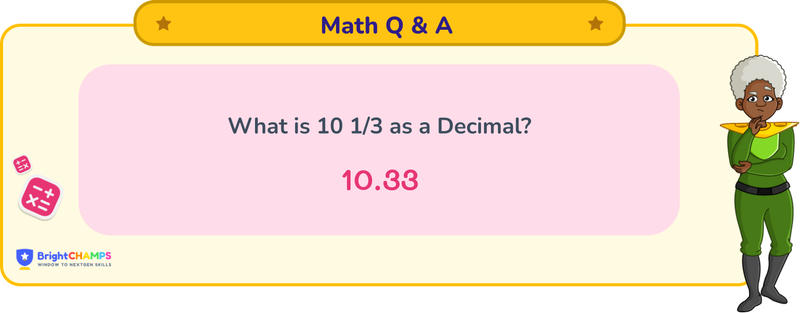
 220 Learners
220 LearnersLast updated on 5 August 2025

10 1/3 as a Decimal

It is a simple question on decimal conversion. Firstly, we have to learn fractions and decimals. A fraction represents a part of the whole. It has two parts: the numerator (number on the top), here, 1 represents how many parts out of the whole. The denominator (number below) shows how many parts make the whole, here it is 3. A decimal is a way to represent a number that is not whole, using a (.) or a decimal to separate the whole part from the fraction part. The numbers to the left of the decimal point represent the whole, and those to the right represent the fractional part.
What is 10 1/3 as a decimal?

Answer
10 1/3 in decimals can be written as 10.3333…. It is a recurring decimal, indicating it will repeat the same digit infinitely.
Explanation
To convert 10 1/3 to a decimal, we will first convert 1/3 to a decimal. Using the division method, 1 divided by 3 gives us 0.3333. Adding this to 10 gives us 10.3333. Let's break down the process step by step:
Step 1: Identify the mixed number, which consists of the whole number 10 and the fraction 1/3.
Step 2: Convert the fraction 1/3 to a decimal. Here, 1 is smaller than 3, so we use the decimal method, resulting in 0.3333.
Step 3: Add 0.3333 to the whole number 10, resulting in 10.3333. The division process continues as a recurring decimal.
Therefore, the answer for 10 1/3 as a decimal is 10.3333….
Important Glossaries for 10 1/3 as a decimal
- Fraction: A numerical quantity that is not a whole number, representing a part of a whole.
- Decimal: A number that uses the base ten and includes a decimal point to separate the whole part from the fractional part.
- Numerator: The top part of a fraction, indicating how many parts of the whole are being considered.
- Denominator: The bottom part of a fraction, showing how many parts make up a whole.
- Recurring Decimal: A decimal that repeats the same sequence of digits infinitely.




